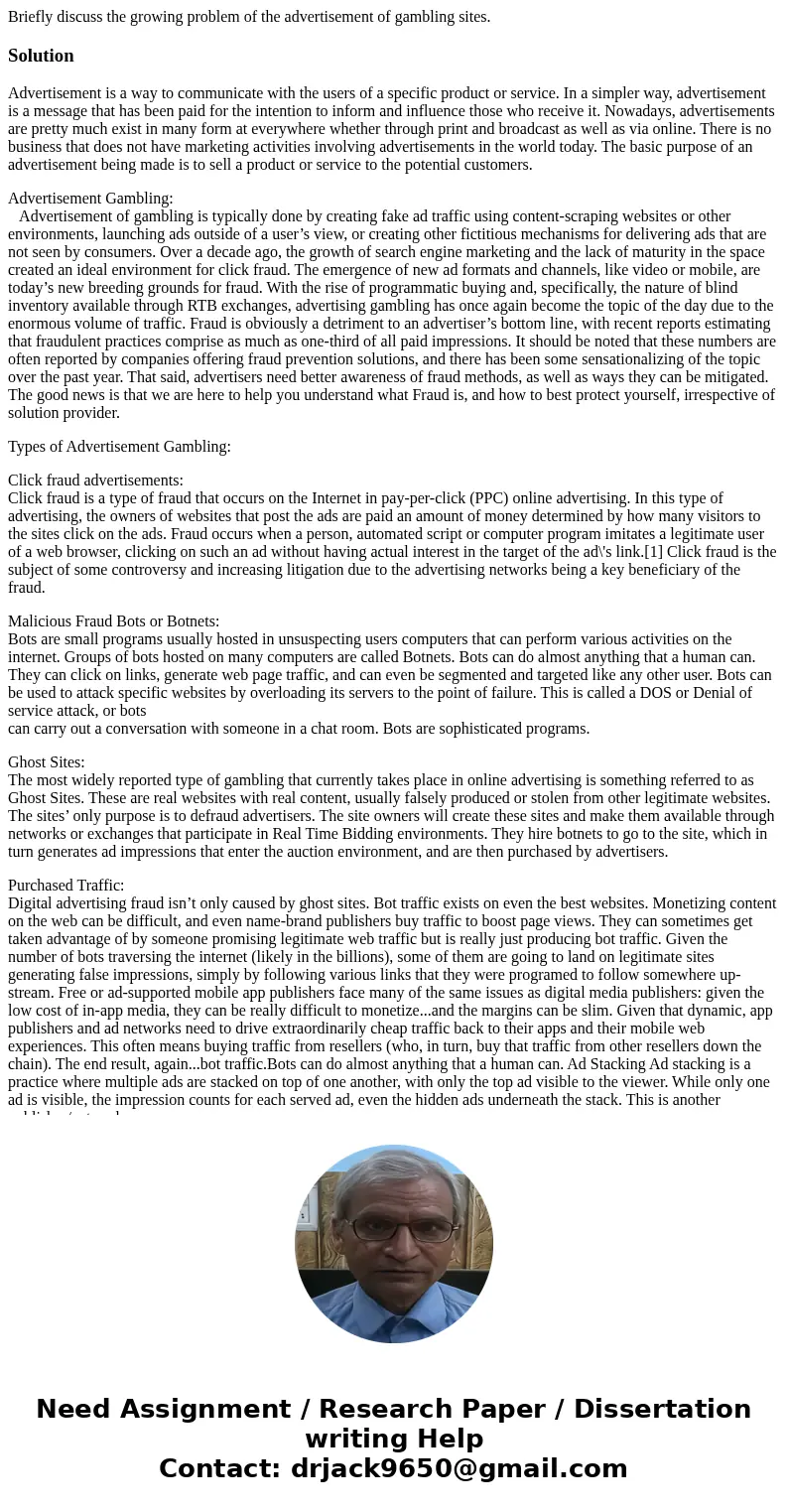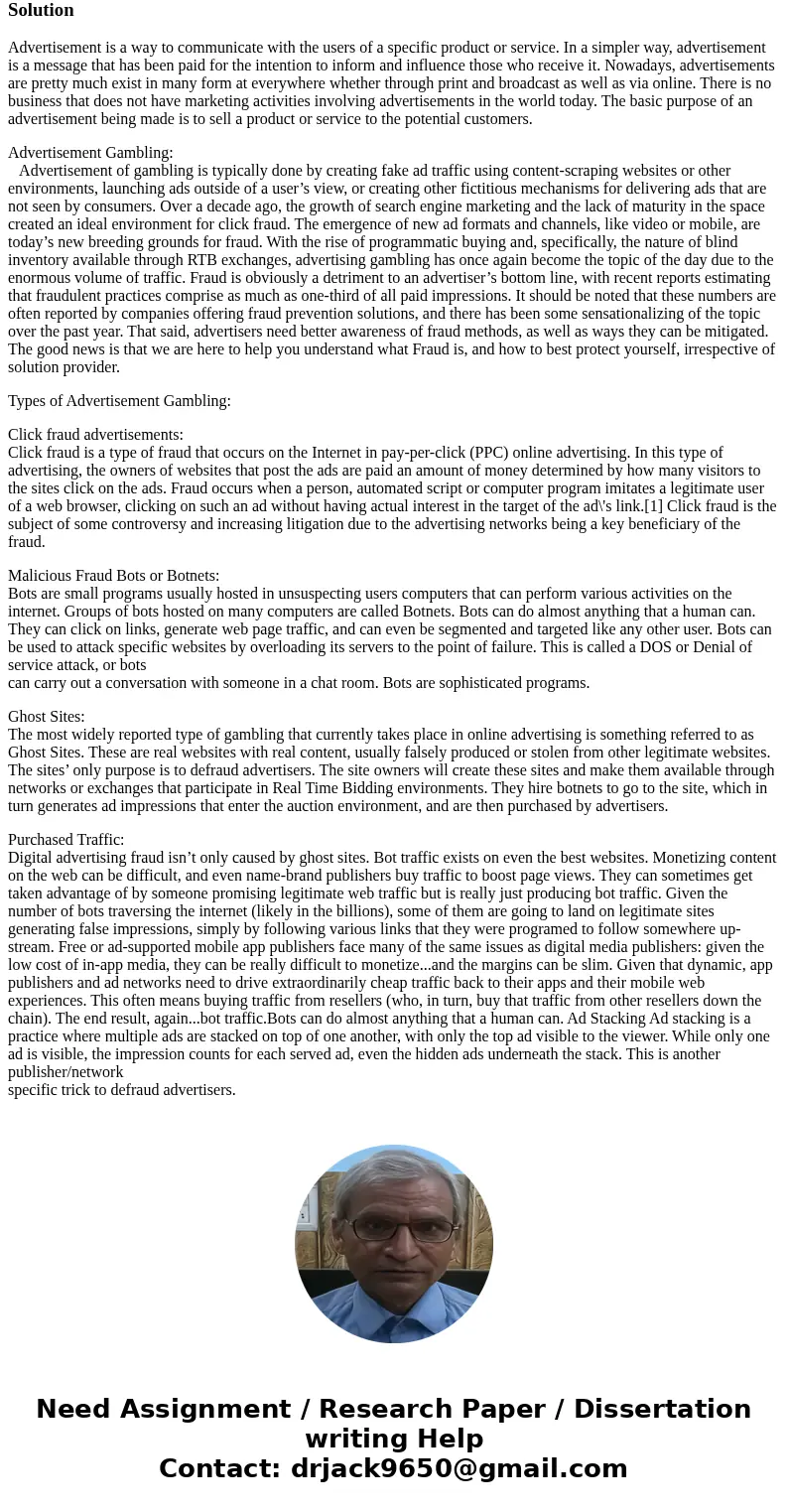Briefly discuss the growing problem of the advertisement of
Briefly discuss the growing problem of the advertisement of gambling sites.
Solution
Advertisement is a way to communicate with the users of a specific product or service. In a simpler way, advertisement is a message that has been paid for the intention to inform and influence those who receive it. Nowadays, advertisements are pretty much exist in many form at everywhere whether through print and broadcast as well as via online. There is no business that does not have marketing activities involving advertisements in the world today. The basic purpose of an advertisement being made is to sell a product or service to the potential customers.
Advertisement Gambling:
Advertisement of gambling is typically done by creating fake ad traffic using content-scraping websites or other environments, launching ads outside of a user’s view, or creating other fictitious mechanisms for delivering ads that are not seen by consumers. Over a decade ago, the growth of search engine marketing and the lack of maturity in the space created an ideal environment for click fraud. The emergence of new ad formats and channels, like video or mobile, are today’s new breeding grounds for fraud. With the rise of programmatic buying and, specifically, the nature of blind inventory available through RTB exchanges, advertising gambling has once again become the topic of the day due to the enormous volume of traffic. Fraud is obviously a detriment to an advertiser’s bottom line, with recent reports estimating that fraudulent practices comprise as much as one-third of all paid impressions. It should be noted that these numbers are often reported by companies offering fraud prevention solutions, and there has been some sensationalizing of the topic over the past year. That said, advertisers need better awareness of fraud methods, as well as ways they can be mitigated. The good news is that we are here to help you understand what Fraud is, and how to best protect yourself, irrespective of solution provider.
Types of Advertisement Gambling:
Click fraud advertisements:
Click fraud is a type of fraud that occurs on the Internet in pay-per-click (PPC) online advertising. In this type of advertising, the owners of websites that post the ads are paid an amount of money determined by how many visitors to the sites click on the ads. Fraud occurs when a person, automated script or computer program imitates a legitimate user of a web browser, clicking on such an ad without having actual interest in the target of the ad\'s link.[1] Click fraud is the subject of some controversy and increasing litigation due to the advertising networks being a key beneficiary of the fraud.
Malicious Fraud Bots or Botnets:
Bots are small programs usually hosted in unsuspecting users computers that can perform various activities on the internet. Groups of bots hosted on many computers are called Botnets. Bots can do almost anything that a human can. They can click on links, generate web page traffic, and can even be segmented and targeted like any other user. Bots can be used to attack specific websites by overloading its servers to the point of failure. This is called a DOS or Denial of service attack, or bots
can carry out a conversation with someone in a chat room. Bots are sophisticated programs.
Ghost Sites:
The most widely reported type of gambling that currently takes place in online advertising is something referred to as Ghost Sites. These are real websites with real content, usually falsely produced or stolen from other legitimate websites. The sites’ only purpose is to defraud advertisers. The site owners will create these sites and make them available through networks or exchanges that participate in Real Time Bidding environments. They hire botnets to go to the site, which in turn generates ad impressions that enter the auction environment, and are then purchased by advertisers.
Purchased Traffic:
Digital advertising fraud isn’t only caused by ghost sites. Bot traffic exists on even the best websites. Monetizing content on the web can be difficult, and even name-brand publishers buy traffic to boost page views. They can sometimes get taken advantage of by someone promising legitimate web traffic but is really just producing bot traffic. Given the number of bots traversing the internet (likely in the billions), some of them are going to land on legitimate sites generating false impressions, simply by following various links that they were programed to follow somewhere up-stream. Free or ad-supported mobile app publishers face many of the same issues as digital media publishers: given the low cost of in-app media, they can be really difficult to monetize...and the margins can be slim. Given that dynamic, app publishers and ad networks need to drive extraordinarily cheap traffic back to their apps and their mobile web experiences. This often means buying traffic from resellers (who, in turn, buy that traffic from other resellers down the chain). The end result, again...bot traffic.Bots can do almost anything that a human can. Ad Stacking Ad stacking is a practice where multiple ads are stacked on top of one another, with only the top ad visible to the viewer. While only one ad is visible, the impression counts for each served ad, even the hidden ads underneath the stack. This is another publisher/network
specific trick to defraud advertisers.


 Homework Sourse
Homework Sourse